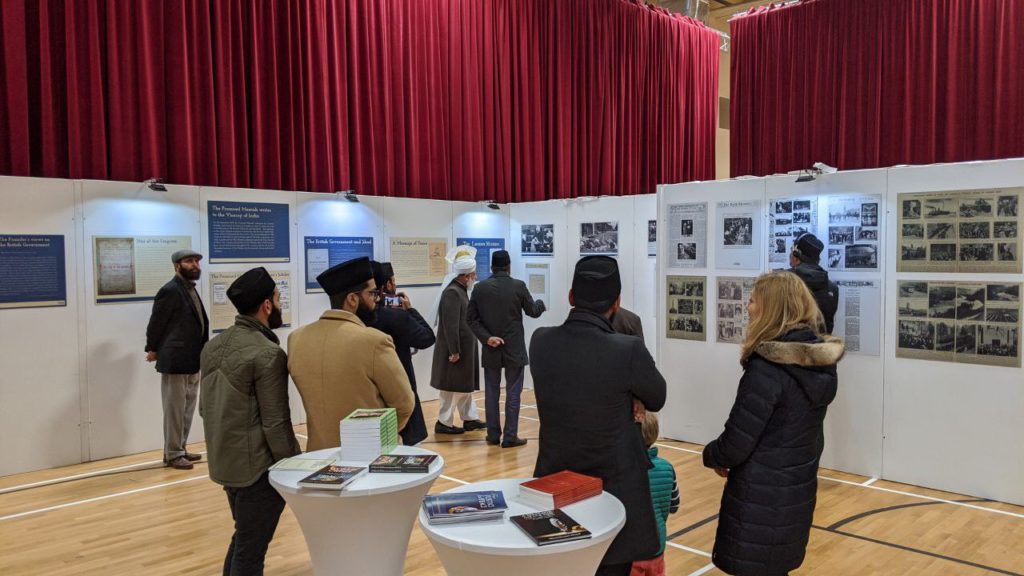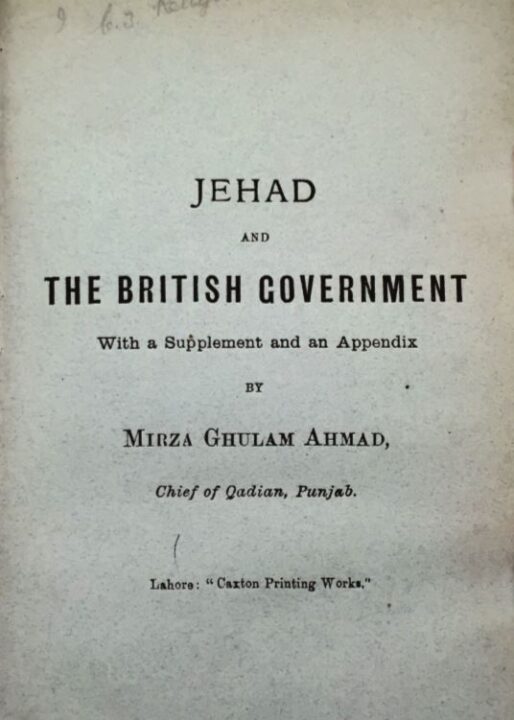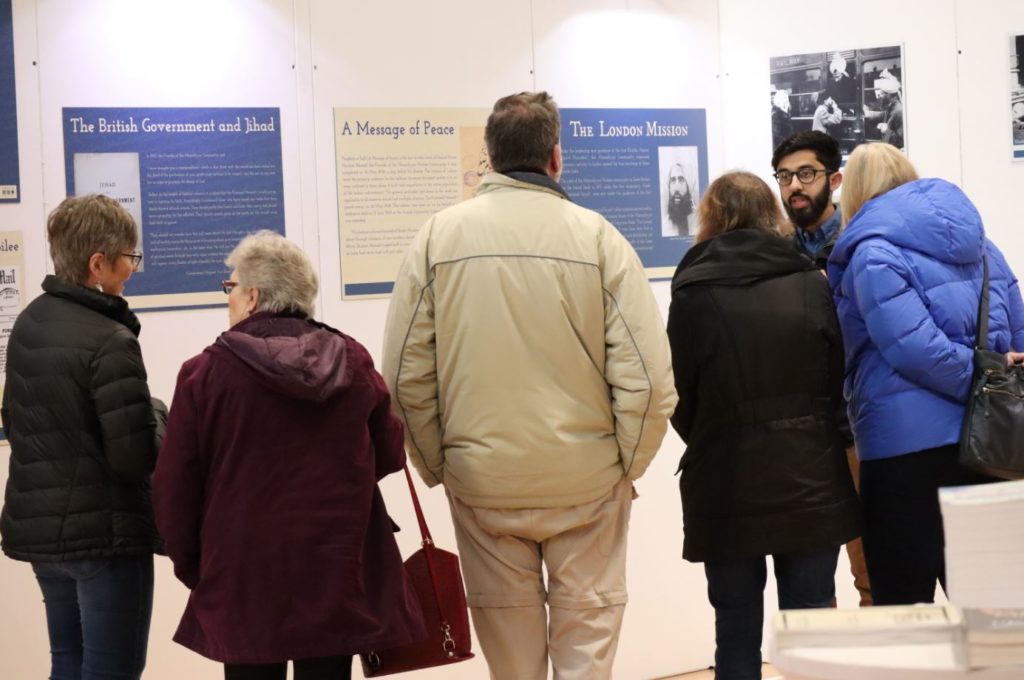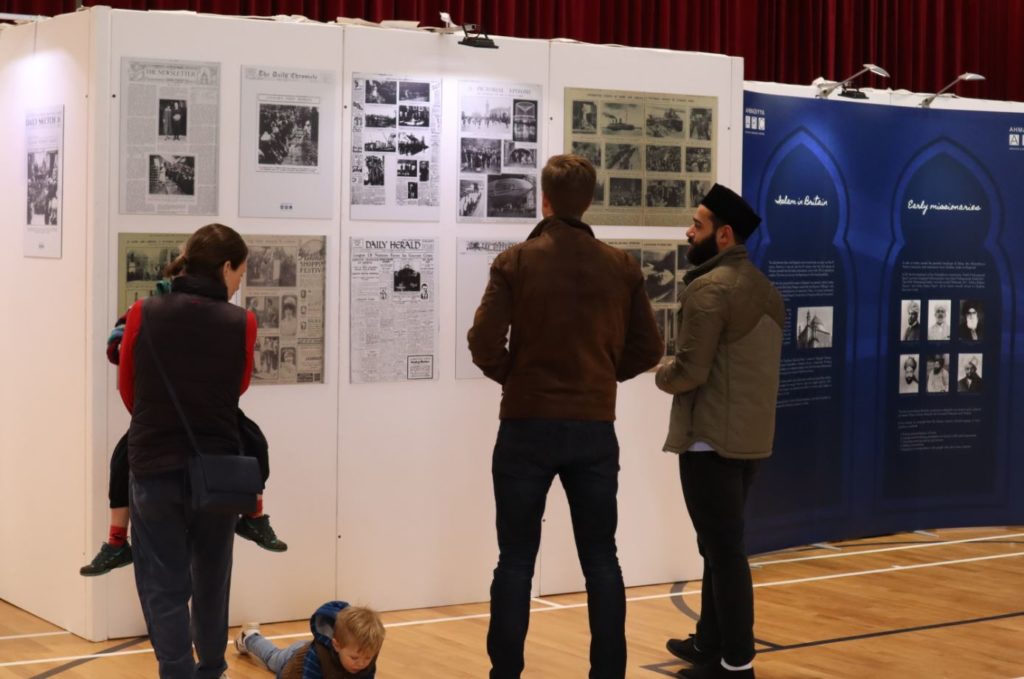
It is quite normal to expect rain and chilly breezes of early March in England; so normal that everything goes on as usual. Things went on more than normal on 7 and 8 March when the Ahmadiyya Archive and Research Centre opened the doors of Masroor Hall in Islamabad for local neighbours.
In the hall stood an exhibition themed “The Westerly Sunrise” where history of the Ahmadiyya Muslim Jamaat in Britain was depicted in pictorial form with supporting text. The first wing brought to life the Jamaat’s history from the time of the Holy Founder of the Ahmadiyya Jamaat in Islam, Hazrat Mirza Ghulam Ahmad, on whom be peace; his correspondence with Queen Victoria where he introduced her to the message of Islam and invited her to accept it was also explained here.
The visuals in this wing included title pages of the first editions of the following books that carried this message: Aina-e-Kamalat-e-Islam, Nur-ul-Haq and Star of the Empress.

Covered too were the Promised Messiah’sas correspondence with the British-Indian Government in relation to the teachings of Islam regarding coexistence in a society like the British-India and to not to take up arms against just and tolerant rulers like the British.
Tour guides would tell guests about the Promised Messiah’sas work “Jehad and the British Government”, how he got it printed in bulk, arranged for distribution in areas of major uprisings like Peshawar and the North-Western Province and how he offered government officials to provide more copies of the work to circulate them at a wider scale.
The foundation of the Ahmadiyya Jamaat’s London Mission in 1913 naturally caught the attention of visitors of the exhibition and more so, the 1924 England tour of Hazrat Mirza Bashiruddin Mahmud Ahmad, Khalifatul Masih IIra.
Visitors found it fascinating to learn that Hazrat Khalifatul Masih IIra was invited all the way from India to address the Conference of Living Religions of the Empire by School of Oriental Studies and the Sociological Society, the conference being a part of the British Empire Exhibition.

Associated with this episode was the story of the corner-stone laying of the Fazl Mosque – London’s first mosque. As the majority of visitors were from the local neighbourhood of Islamabad – who have only known us since 1984 – the story of the Fazl Mosque extended their knowledge of the Jamaat’s history to almost a hundred years back.
The next part of the exhibition shed light on the literature produced by Hazrat Khalifatul Masih IIra directly addressing the officials of the British-Indian government. Guests were given a glimpse of this rich literature that provided insight into Quranic teachings on inter-faith harmony, inter-communal coexistence, loyalty to the rulers and also on political themes when it came to handing over the governance of India to the Indian people and, for that matter, the drawing of a boundary to divide the subcontinent into two countries: India and Pakistan.
Great interest was shown in the remarks of Edwin Samuel Montagu – then Secretary of State for India – during his visit to Lahore. He had expressed that of all advice received by social and political circles of India, Hazrat Khalifatul Masih II’sra was the most thoroughly researched, thought over and one based on realistic expectations.

The photograph of Hazrat Khalifatul Masih IIIrh, stepping out of the Fazl Mosque would usually hold the gaze of visitors when told that it was in this mosque that he launched a grand-scale humanitarian scheme to alleviate the sufferings of the under-privileged parts of Africa.
The Nusrat Jehan Scheme, as it is called, has had hundreds of Ahmadis leaping forward to contribute towards the noble cause; the most prominent of such devotees being Hazrat Mirza Masroor Ahmadaa, the current head of the Ahmadiyya Muslim Community, when he first devoted his life in early 1970s.
Huzooraa lived in Ghana for many years and served on educational and agricultural fronts, before returning to Pakistan after great services spanning over almost a decade-and-a-half.
The migration of Khilafat-e-Ahmadiyya from Pakistan to London is a story that most locals knew about, but it worked as a reminder of many details that can fade in memories with time. This wing of the exhibition caught attention as the migration and the purchase of the land of Islamabad had happened like twin-birth.
A spike in interest could be visibly seen as guests walked on to the wing that focused on Hazrat Khalifatul Masih Vaa – the great man who is their neighbour, as described by a number of local-resident visitors of the exhibition.

Most local residents have visited Islamabad on several occasions, but the displayed aerial view of the newly refurbished Islamabad caught the eye of many guests. What they had always seen as rundown barracks, weathered by the flight of time, did most definitely serve as a feast for their eyes – or anyone’s eyes for that matter; it is a spectacular view of the Mubarak Mosque, Huzoor’saa offices and the attached residential colony.
This led to the final wing of the exhibition where guests could see a glimpse of how dignitaries, intellectuals and heads of states take pride in having an audience with Huzooraa, where they get a chance to be enlightened about contemporary affairs concerning their religious, social, economic, national and international interests.
Highlight of the exhibition
The exhibition had been up for only a few hours on Saturday, 7 March, when Huzooraa blessed it with his presence. After leading the Asr prayer, Huzooraa walked to Masroor Hall and visited the exhibition, graciously viewing the displays, asking about various related issues and providing insightful guidance.
The organisers, Ahmadiyya Archive and Research Centre, felt very fortunate and privileged that Huzooraa took time out of his extremely busy schedule and walked through every aisle and wing of the exhibition.
Prominent guests
Pat Evans, the Mayor of Farnham and Mary Foryszewski, Mayor of Waverley Borough Council (the home-borough of Islamabad, Tilford) both took time out to visit the exhibition in the early part of Saturday afternoon. Both have been very good friends of the Jamaat and have seen Islamabad flourish into what it is today, yet the historical material displayed in the exhibition opened new avenues for their perception about the Jamaat.
Both the mayors stayed in the exhibition for more than an hour respectively to go through the whole exhibition.
Comments by guests
Most visitors expressed a great deal of appreciation in their remarks that they jotted down in the visitor’s book. We present only a few that represent the spirit of all remarks by the visitors:
“What a privilege to be a neighbour of His Holiness”.
“What a fascinating experience”.
“This exhibition has given a new dimension to my perception about the Ahmadiyya”.

